Abstract
The interaction of monovalent hapten dinitrophenyl epsilon-amino caproic acid (DNP-EACA) with purified IgG1 sheep anti-DNP precipitating and non-precipitating antibodies, and their F(ab')2, F(ab') and Fab fragments, was studied by fluorescence quenching and by a radioimmunoassay. The Scatchard plots of whole non-precipitating antibody and its F(ab')2 fragment showed a bi-modal curve that could be interpreted as due to the existence of two populations of sites with very different affinity for the ligand, each population representing 50% of the total number of sites. The F(ab) fragments of the non-precipitating antibody could be fractionated by immunoadsorption into two populations of high and low affinity whose association constants differed by more than 2 logs. The study of the interaction of whole antibodies with DNP-bovine serum albumin (BSA) demonstrated that each molecule of precipitating antibody can combine with two molecules of antigen but non-precipitating antibody cannot combine with more than one molecule of antigen. It is concluded that the molecule of non-precipitating antibody is asymmetric and has a site of high affinity and another of low affinity. As a consequence of this structure the non-precipitating antibody behaves functionally as univalent and is unable to form precipitates with the multivalent antigen and to activate effector mechanisms.
Full text
PDF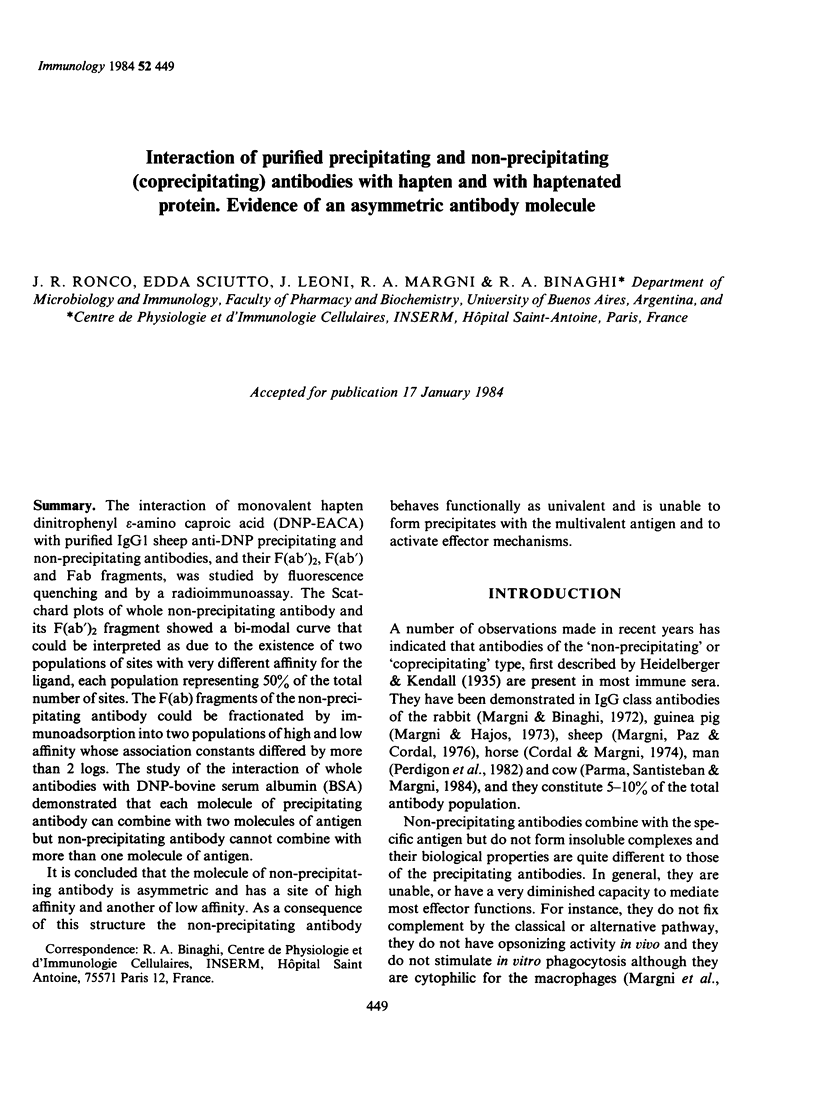
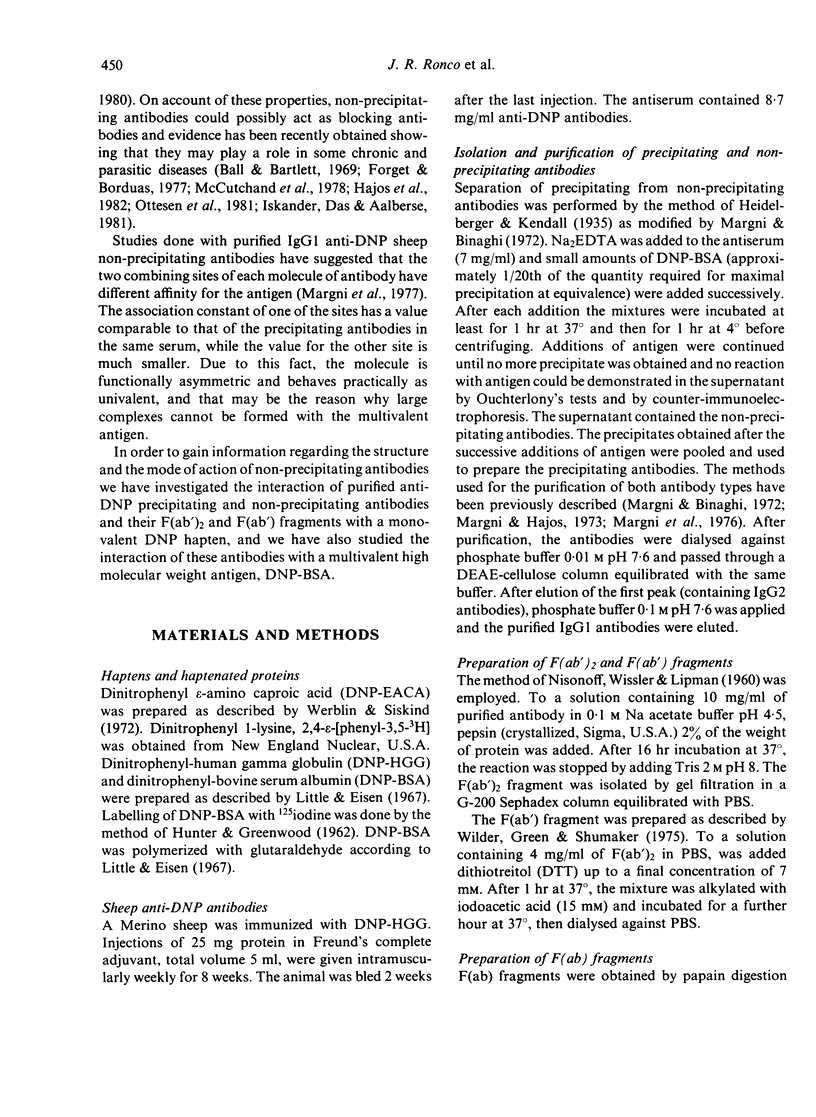
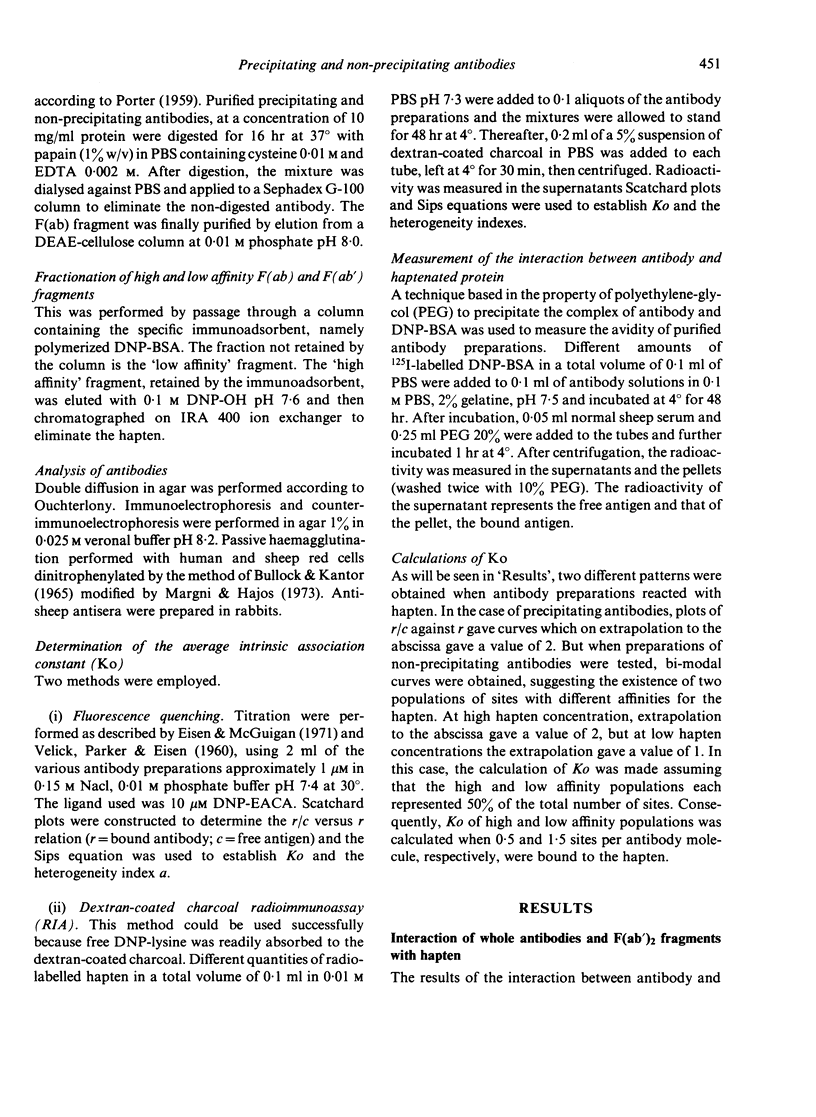
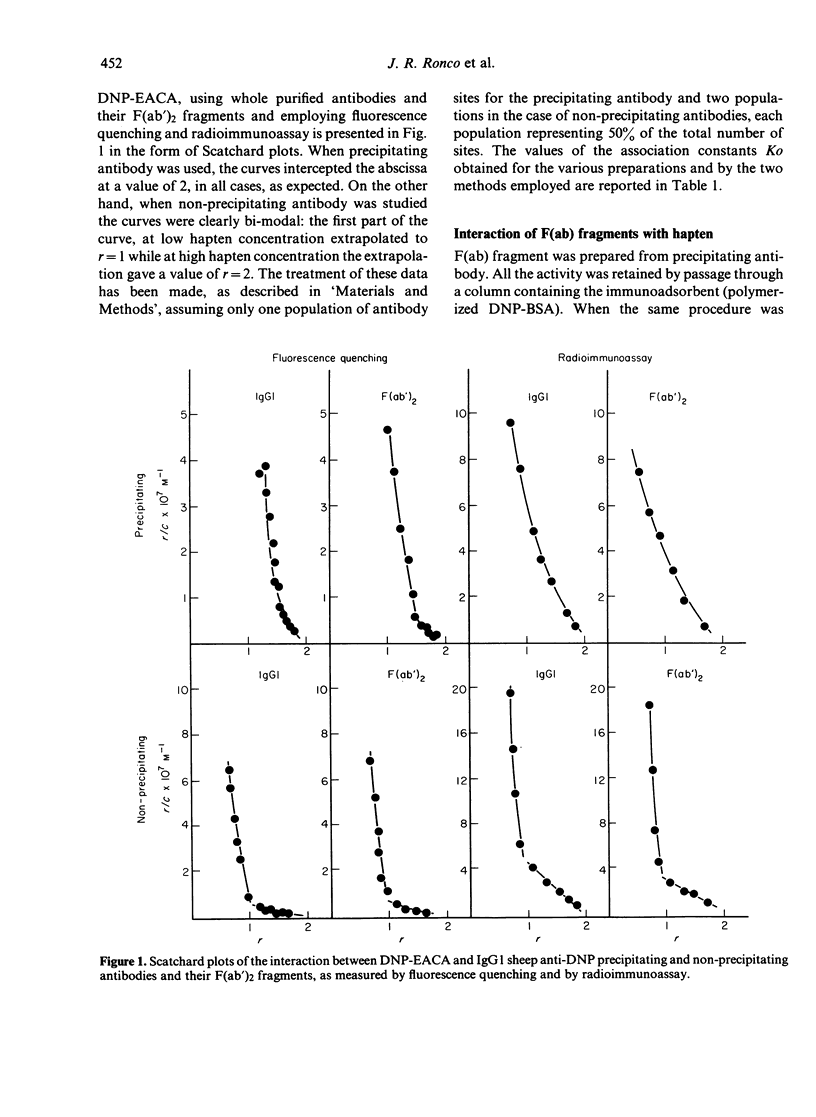
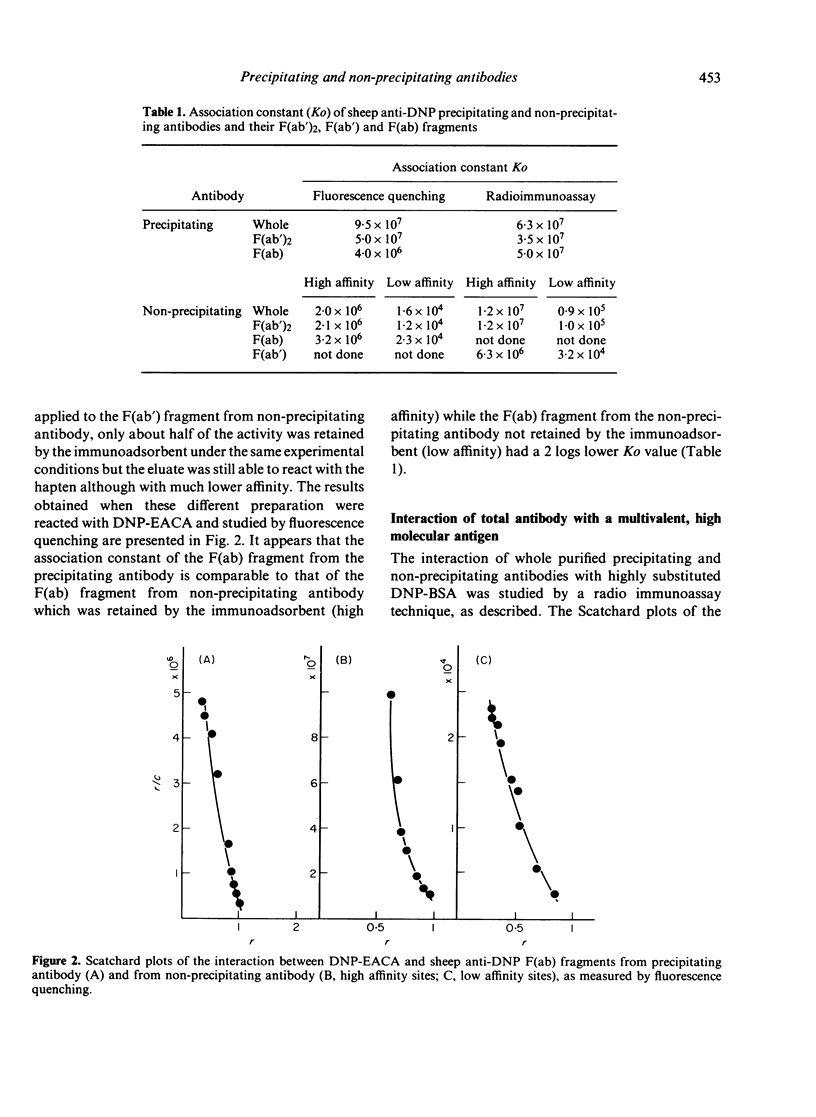
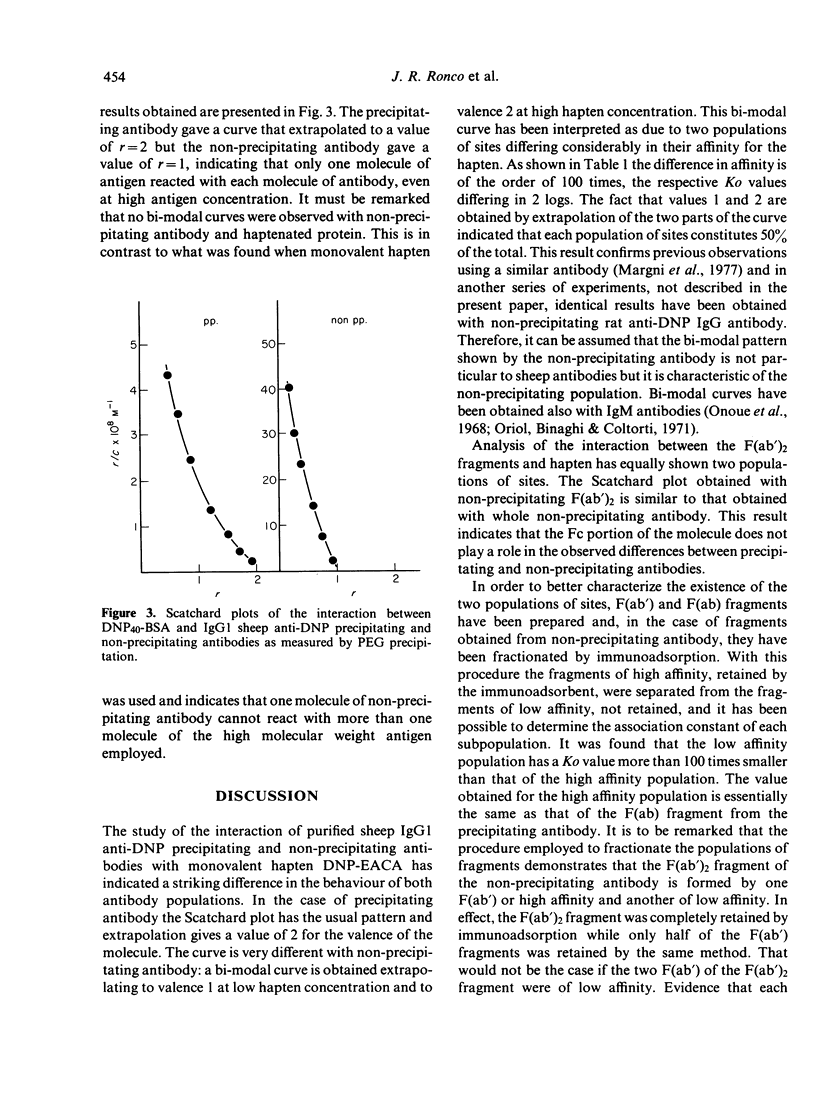
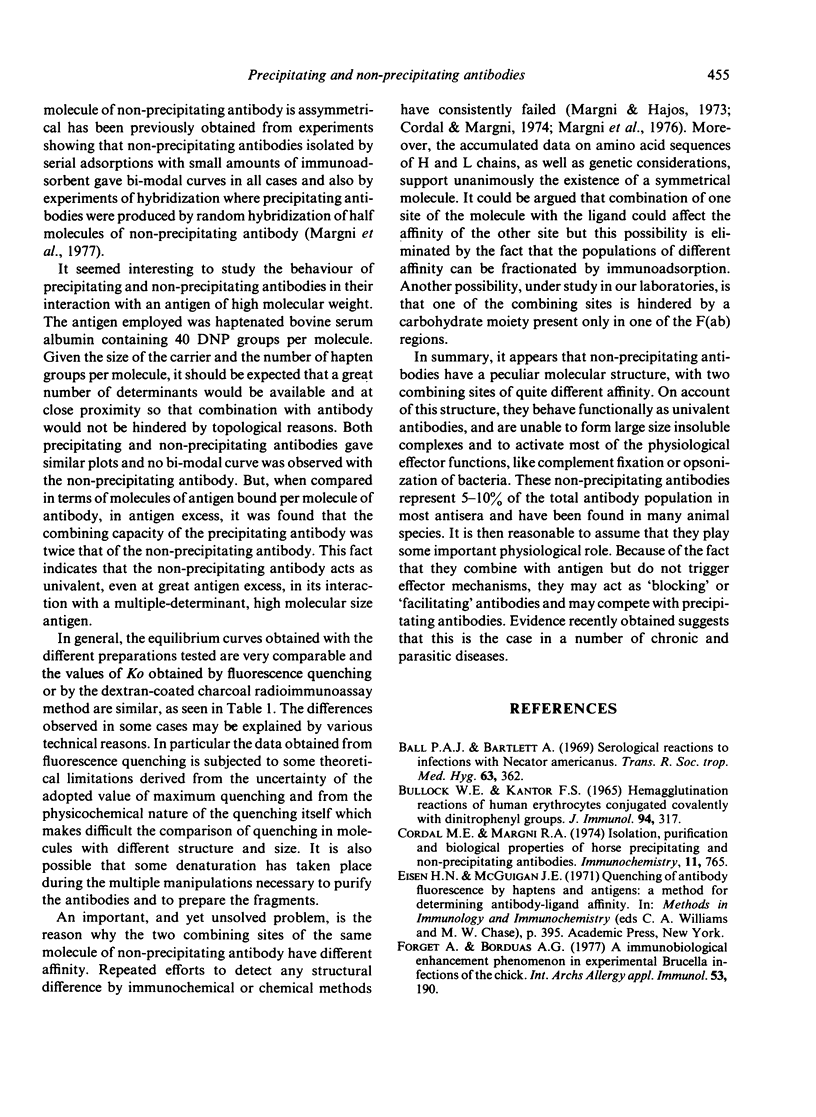
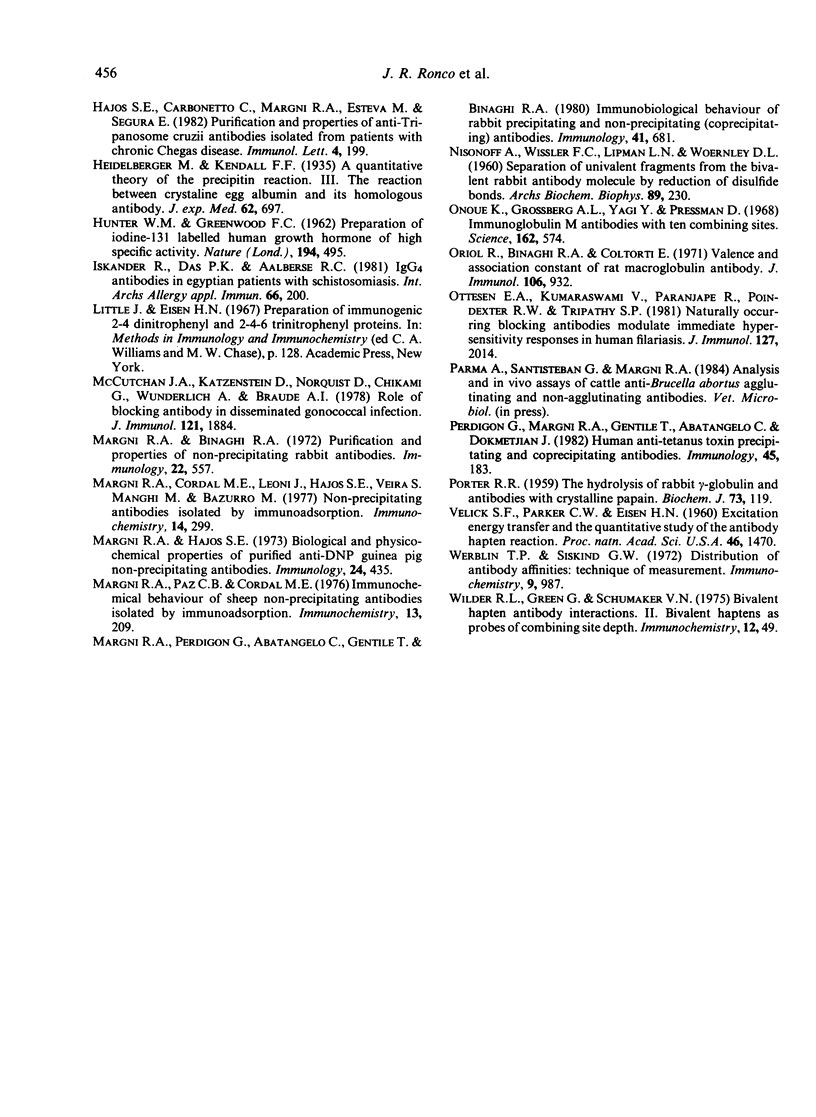
Selected References
These references are in PubMed. This may not be the complete list of references from this article.
- BULLOCK W. E., KANTOR F. S. HEMAGGLUTINATION REACTIONS OF HUMAN ERYTHROCYTES CONJUGATED COVALENTLY WITH DINITROPHENYL GROUPS. J Immunol. 1965 Mar;94:317–322. [PubMed] [Google Scholar]
- Ball P. A., Bartlett A. Serological reactions to infection with Necator americanus. Trans R Soc Trop Med Hyg. 1969;63(3):362–369. doi: 10.1016/0035-9203(69)90011-x. [DOI] [PubMed] [Google Scholar]
- Cordal M. E., Margni R. A. Isolation, purification and biological properties of horse precipitating and non precipitating antibodies. Immunochemistry. 1974 Dec;11(12):765–770. doi: 10.1016/0019-2791(74)90295-x. [DOI] [PubMed] [Google Scholar]
- Forget A., Borduas A. G. An immunological enhancement phenomenon in experimental brucella infection of the chicks. Int Arch Allergy Appl Immunol. 1977;53(2):190–194. doi: 10.1159/000231751. [DOI] [PubMed] [Google Scholar]
- HUNTER W. M., GREENWOOD F. C. Preparation of iodine-131 labelled human growth hormone of high specific activity. Nature. 1962 May 5;194:495–496. doi: 10.1038/194495a0. [DOI] [PubMed] [Google Scholar]
- Hajos S. E., Carbonetto C., Margni R. A., Esteva M., Segura E. L. Purification and properties of anti-Trypanosoma cruzi antibodies isolated from patients with chronic Chagas' disease. Immunol Lett. 1982 Apr;4(4):199–203. doi: 10.1016/0165-2478(82)90014-1. [DOI] [PubMed] [Google Scholar]
- Iskander R., Das P. K., Aalberse R. C. IgG4 antibodies in Egyptian patients with schistosomiasis. Int Arch Allergy Appl Immunol. 1981;66(2):200–207. doi: 10.1159/000232819. [DOI] [PubMed] [Google Scholar]
- Margni R. A., Cordal M. E., Leoni J., Hajos S. E., Veira S., Manghi M., Bazzurro M. Non-precipitating antibodies isolated by immunoadsorption. Immunochemistry. 1977 Apr;14(4):299–303. doi: 10.1016/0019-2791(77)90253-1. [DOI] [PubMed] [Google Scholar]
- Margni R. A., Hajos S. Biological and physicochemical properties of purified anti-DNP guinea-pig non-precipitating antibodies. Immunology. 1973 Mar;24(3):435–443. [PMC free article] [PubMed] [Google Scholar]
- Margni R. A., Paz C. B., Cordal M. E. Immunochemical behavior of sheep non-precipitating antibodies isolated by immunoadsorption. Immunochemistry. 1976 Mar;13(3):209–214. doi: 10.1016/0019-2791(76)90217-2. [DOI] [PubMed] [Google Scholar]
- Margni R. A., Perdigón G., Abatángelo C., Gentile T., Binaghi R. A. Immunobiological behaviour of rabbit precipitating and non-precipitating (co-precipitating) antibodies. Immunology. 1980 Nov;41(3):681–686. [PMC free article] [PubMed] [Google Scholar]
- Margni R., Binaghi R. Purification and properties of non-precipitating rabbit antibodies. Immunology. 1972 Apr;22(4):557–563. [PMC free article] [PubMed] [Google Scholar]
- McCutchan J. A., Katzenstein D., Norquist D., Chikami G., Wunderlich A., Braude A. I. Role of blocking antibody in disseminated gonococcal infection. J Immunol. 1978 Nov;121(5):1884–1888. [PubMed] [Google Scholar]
- NISONOFF A., WISSLER F. C., LIPMAN L. N., WOERNLEY D. L. Separation of univalent fragments from the bivalent rabbit antibody molecule by reduction of disulfide bonds. Arch Biochem Biophys. 1960 Aug;89:230–244. doi: 10.1016/0003-9861(60)90049-7. [DOI] [PubMed] [Google Scholar]
- Onoue K., Grossberg A. L., Yagi Y., Pressman D. Immunoglobulin M antibodies with ten combining sites. Science. 1968 Nov 1;162(3853):574–576. doi: 10.1126/science.162.3853.574. [DOI] [PubMed] [Google Scholar]
- Oriol R., Binaghi R., Coltorti E. Valence and association constant of rat macroglobulin antibody. J Immunol. 1971 Apr;106(4):932–937. [PubMed] [Google Scholar]
- Ottesen E. A., Kumaraswami V., Paranjape R., Poindexter R. W., Tripathy S. P. Naturally occurring blocking antibodies modulate immediate hypersensitivity responses in human filariasis. J Immunol. 1981 Nov;127(5):2014–2020. [PubMed] [Google Scholar]
- PORTER R. R. The hydrolysis of rabbit y-globulin and antibodies with crystalline papain. Biochem J. 1959 Sep;73:119–126. doi: 10.1042/bj0730119. [DOI] [PMC free article] [PubMed] [Google Scholar]
- Perdigón G., Margni R. A., Gentile T., Abatángelo C., Dokmetjian J. Human anti-tetanus toxin precipitating and co-precipitating antibodies. Immunology. 1982 Jan;45(1):183–190. [PMC free article] [PubMed] [Google Scholar]
- Velick S. F., Parker C. W., Eisen H. N. EXCITATION ENERGY TRANSFER AND THE QUANTITATIVE STUDY OF THE ANTIBODY HAPTEN REACTION. Proc Natl Acad Sci U S A. 1960 Nov;46(11):1470–1482. doi: 10.1073/pnas.46.11.1470. [DOI] [PMC free article] [PubMed] [Google Scholar]
- Werblin T. P., Siskind G. W. Distribution of antibody affinities: technique of measurement. Immunochemistry. 1972 Oct;9(10):987–1011. doi: 10.1016/0019-2791(72)90110-3. [DOI] [PubMed] [Google Scholar]


